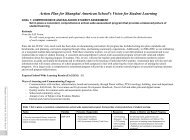Curriculum and Instruction - SAS-WASC
Curriculum and Instruction - SAS-WASC
Curriculum and Instruction - SAS-WASC
You also want an ePaper? Increase the reach of your titles
YUMPU automatically turns print PDFs into web optimized ePapers that Google loves.
AlignmentAligning divisions across campuses through the curriculum has progressed steadilyover the past two years with the help of Atlas, common st<strong>and</strong>ards <strong>and</strong> benchmarks,<strong>and</strong> both time <strong>and</strong> technology that has allowed for greater collaboration amongteachers. Another area for alignment that impacts curriculum is the time allotted tosubjects. In the elementary <strong>and</strong> high school divisions, the discrepancies betweencampuses continue to be successfully addressed.In the spring of 2008, the middle school alignment committee took up the chargeof aligning middle school campus schedules to ensure equal time for specials oneach campus – necessary if st<strong>and</strong>ards <strong>and</strong> benchmarks are going to be taught <strong>and</strong>learned in the same way. Their aim is to create a common middle school vision <strong>and</strong>philosophy as well as to align schedules to provide equal time for subjects. Theirstudy is not complete <strong>and</strong> will continue into 2008-2009, aiming for implementationin 2009-2010 (see the middle school alignment report appended to the Organizationfor Student Learning chapter of the self study). The cross campus alignment ofmiddle school schedules will be critical to student equity of access to learning,particularly in specialists’ areas such as music, drama, art, health <strong>and</strong> physicaleducation.Engaging StudentsTeachers at <strong>SAS</strong> design <strong>and</strong> implement a variety of learning experiences that engagestudents at a high level of learning consistent with the EAGLES. The range of theseactivities is indicated in Subject Area Evidence Binders, where students draw, write,discuss, role-play <strong>and</strong> listen their way to meaning, using strategies that nurture avariety of learning styles. There are many examples in day-to-day teaching. A fewhighlights occurring beyond the classroom include Pudong’s posting of TOK lessonson YouTube for the world to learn from <strong>and</strong> Puxi students’ research at the SeatruTurtle Research site of the University of Terranganu in Malaysia. In the middleschools, activities such as the Puxi’s grade six “Notables” or the Pudong’s gradesseven <strong>and</strong> eight Great Race st<strong>and</strong> as examples. In the elementary schools, Pudong’sgrade four students are fully engaged in a terra cotta warrior archeological dig <strong>and</strong>Puxi’s grade four Chinese Exhibition project.“Language arts, social studies, <strong>and</strong>science were all integrated intotheir invention convention.” - CodyHowitt, elementary school teacherAreas of Strength: (tied to <strong>SAS</strong> Vision points)<strong>SAS</strong> teachers are skilled practitioners who involve students in a variety of authentic<strong>and</strong> meaningful learning experiences.Engage <strong>and</strong> support teachers, administrators, <strong>and</strong> staff in a unique professionallearning community that provides opportunities to grow, develop, <strong>and</strong> learntogether in all aspects of their professional lives.•Collaboration within divisions is emerging.• <strong>SAS</strong> has dedicated time through <strong>Curriculum</strong> Wednesdays to professionallearning <strong>and</strong> work on curricular goals in departments <strong>and</strong> teams.• Developing deeper relationships <strong>and</strong> using outside consultants <strong>and</strong> a scholarin-residenceover a longer term has allowed for growing emphasis onpositive school culture <strong>and</strong> looking at how students learn.• <strong>SAS</strong> teachers are leaders of professional learning through Teachers TeachingTeachers.• Learning support staff, including ESOL <strong>and</strong> academic support teachers <strong>and</strong>counselors, work collaboratively with classroom teachers.• The partnership with Plymouth State University shows meaningful impact onthe conversations participating teachers are having about their own learning<strong>and</strong> that of their students.Shanghai American School Self Study Report 83



